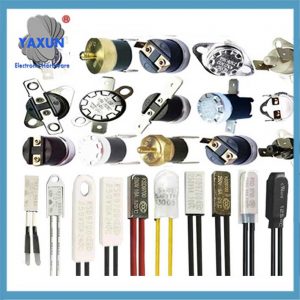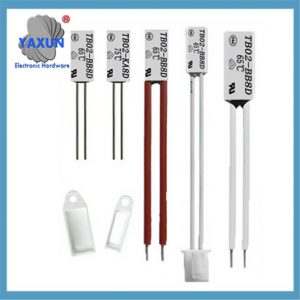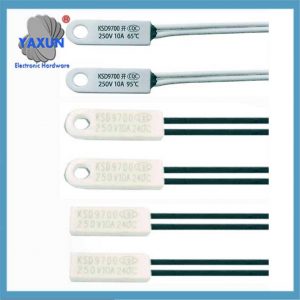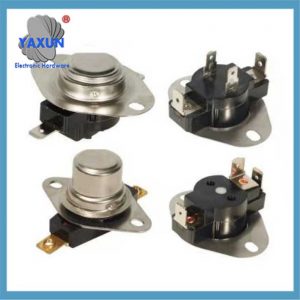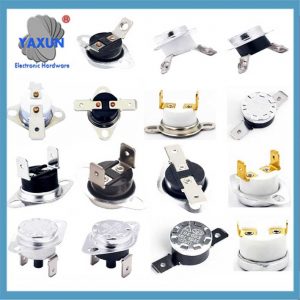La siguiente es la guía de diferencia y selección del núcleo del KSD301 bimetálico, KSD9700 Normalmente cerrado (CAROLINA DEL NORTE) y normalmente abierto (NO) interruptores de temperatura, y una comparación completa de especificaciones técnicas y escenarios de aplicaciones:
I. Principio de trabajo y definición de estado
| Características | Normalmente cerrado (CAROLINA DEL NORTE) | Normalmente abierto (NO) |
| Estado inicial | Contactos cerrados a temperatura normal (Circuito conectado) | Contactos desconectados a temperatura normal (Circuito desconectado) |
| Acción de activación | Temperatura ≥ valor establecido → contactos desconectados (Circuito desconectado) | Temperatura ≥ valor establecido → contactos cerrados (Circuito conectado) |
| Mecanismo de referencia | Caídas de temperatura para restablecer el valor → contactos cerrados automáticamente | Caídas de temperatura para restablecer el valor → contactos desconectados automáticamente |
| Símbolo | NC (Normalmente cerrado) | No (normalmente abierto) |
Lógica de la aplicación central:
NC Tipo: “Alta temperatura apagada” (como evitar que el motor se sobrecaliente y queme);
No tipo: “Alta temperatura” (como la sobre-temperatura que comienza el ventilador de enfriamiento).
II. Escenarios de aplicación típicos
Parámetros del interruptor de temperatura KSD301
| Tipo | Equipo aplicable | Propósito de protección |
| Tipo de NC | – Protección contra el sobrecalentamiento del motor (lavadora, compresor de aire acondicionado) – Calentador de agua eléctrico anti-secado – Protección contra sobrecarga de transformadores |
Cuando la temperatura excede el estándar, La fuente de alimentación se ve obligada a ser cortada para evitar daños al equipo. |
| No tipo | – Control del ventilador de enfriamiento (CPU de computadora, gabinete) – Alarma de sobretemperatura del calentador – Sistema de calefacción de invernadero |
Activar el equipo auxiliar (como ventiladores/alarmas) Cuando la temperatura excede el estándar |
III. Consideraciones clave para la selección
Prioridad de seguridad
NC El tipo debe seleccionarse para escenarios de apagado forzado (como la prevención del fuego, Prevención de descargas eléctricas) Para evitar los accidentes causados por el suministro de energía continua a altas temperaturas.
Circuito de diseño de circuito
El tipo NC debe conectarse en serie en el cable vivo del circuito principal, y ningún tipo generalmente está conectado en paralelo a controlar el equipo auxiliar.
identificación
“B” o “CAROLINA DEL NORTE” Marcado en la carcasa indica un tipo normalmente cerrado, “k” o “NO” indica un tipo normalmente abierto (como KSD301-85B indica un tipo normalmente cerrado a 85 ℃).
Verificación de prueba
Use un multímetro para detectar: El tipo NC está conectado a temperatura normal, y ningún tipo está desconectado a temperatura normal.
IV. Evitar errores operativos
código de copia de sirena
Gráfico TB
A[Requisitos del equipo] –> B{¿Necesita ser alimentado a alta temperatura?? }
B –>|Sí| do[Seleccione Tipo NC]
B –>|No| D{Es necesario iniciar a alta temperatura? }
D –>|Sí| mi[Seleccione ningún tipo]
D –>|No| F[Reevaluar el diseño]
▶ ️ MUMMARY: El tipo de NC es el “freno de emergencia” para protección contra la seguridad, y ningún tipo es el “desencadenante de temperatura” para control inteligente. Las lógicas de acción de los dos son complementarias. La selección debe coincidir estrictamente con los requisitos de la función del circuito (integral).
 English
English Afrikaans
Afrikaans العربية
العربية বাংলা
বাংলা bosanski jezik
bosanski jezik Български
Български Català
Català 粤语
粤语 中文(简体)
中文(简体) 中文(漢字)
中文(漢字) Hrvatski
Hrvatski Čeština
Čeština Nederlands
Nederlands Eesti keel
Eesti keel Suomi
Suomi Français
Français Deutsch
Deutsch Ελληνικά
Ελληνικά हिन्दी; हिंदी
हिन्दी; हिंदी Magyar
Magyar Bahasa Indonesia
Bahasa Indonesia Italiano
Italiano 日本語
日本語 한국어
한국어 Latviešu valoda
Latviešu valoda Lietuvių kalba
Lietuvių kalba македонски јазик
македонски јазик Bahasa Melayu
Bahasa Melayu Norsk
Norsk پارسی
پارسی Polski
Polski Português
Português Română
Română Русский
Русский Cрпски језик
Cрпски језик Slovenčina
Slovenčina Slovenščina
Slovenščina Español
Español Svenska
Svenska ภาษาไทย
ภาษาไทย Türkçe
Türkçe Українська
Українська اردو
اردو Tiếng Việt
Tiếng Việt

